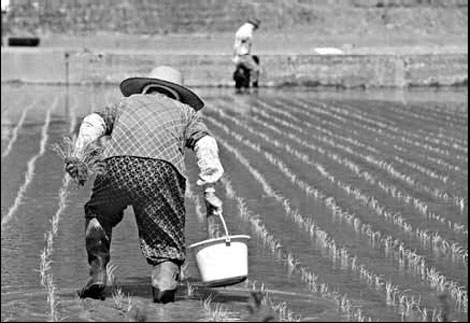After the tsunami, a new variety of rice
Updated: 2012-05-13 07:48
By Yuriko Nagano(The New York Times)
|
|||||||||
|
Salt left behind by the tsunami in Japan has damaged agriculture, in some cases cutting rice yields in half. Everett Kennedy Brown / European Pressphoto Agency |
TOKYO - Toshiharu Ota, a rice farmer in Miyagi Prefecture in northeastern Japan, survived the earthquake, tsunami and nuclear disaster last year. But his fields were devastated by the salt deposits left behind when the tsunami's floodwaters receded.
Salt damage can cut the yield of a rice crop in half.
Now, to help farmers like Mr. Ota, a research team is working to develop a salt-tolerant variety of rice.
"With the rice variety we're developing we should see the yield only drop by 20 percent," said Tomoko Abe at Riken, a research organization. "We should also see less fragmented rice."
The tsunami's waves, up to 40 meters high, engulfed the coastline around Ishinomaki City, where Mr. Ota lives, devastating hundreds of thousands of lives and washing away whole sections of towns and farmland. Miyagi Prefecture estimated the cost of damage to agricultural land and facilities at $4.6 billion, making it one of the prefectures hardest hit economically by the disaster.
Rice has traditionally been a leading crop in northeastern Japan. Miyagi Prefecture's 2010 harvest fetched $818 million. But last year the harvested rice acreage fell short of target by 4,600 hectares. In total, 11 percent of the prefecture's farmland was damaged.
Mr. Ota, who farmed 11 hectares of rice paddies, said nearly half were flooded. Local workers have labored hard to remove salt from the soil in the past year.
"Even with desalination, the yield has dropped," said Mr. Ota, 56.
Once dissolved into the soil, salt is hard to remove. It tends to stick to other elements and comes out only when plant roots emit an acid that breaks away minerals, including sodium chloride, to be absorbed by the plant, he said.
The salt-tolerant rice project involves heavy ion beam technology developed by Riken.
Mainly used in nuclear physics and also in medical applications like cancer treatment, heavy ion beam technology was first applied by Riken to speed up mutations in plants in 1989. Ms. Abe, research group director of accelerator applications at Riken, helped to develop the world's first salt-tolerant rice variety, based on the Nipponbare rice strain, in 2006.
For the current project, grains of two popular rice varieties, Hitomebore and Manamusume, have been exposed to heavy ion beams generated by a particle accelerator.
"We've had success in developing one variety of salt-resistant rice, although this variety doesn't taste that great," said Ms. Abe.
There are only six ion beam accelerator facilities for plant breeding in the world, and four of them are in Japan.
In the year since the tsunami, about 5,250 hectares of farmland in Miyagi Prefecture have been desalinated, including rice paddies. The prefecture aims to clean up an additional 4,100 hectares this year and a final 3,650 hectares in 2013.
Salt-tolerant rice varieties could also help the region cope with land subsidence. Miyagi and surrounding coastal farmlands now face a higher risk of saltwater damage, experts say, because the earthquake's seismic shift caused large parts of northeastern Japan to sink.
Mr. Ota's farmland has sunk by about 80 centimeters. Closer to the epicenter, the subsidence is greater. Oshika Peninsula, just a short drive away, was the closest place to the epicenter of the offshore quake. Land there sank by 1.2 meters and slid horizontally eastward by 5.3 meters, according to the Geospatial Information Authority of Japan.
"We're not dealing with just seawater but also flooding from storms," Mr. Ota said. "We have a sharp increase in drainage water that lingers on our farmland."
Being able to grow a sodium-tolerant variety of rice may determine whether some farmers can continue to stay in agriculture, said Kazuhisa Matsunaga, who works for Zen-noh Miyagi, an agricultural cooperative.
Some coastal farmlands have dropped almost to sea level. "It would make a difference for them to be able to continue farming using a variety that would be forgiving to soil that has some sodium left," Mr. Matsunaga said.
Takashi Endo, a researcher in Miyagi Prefecture, said it could take two years to develop a salt-resistant variety and another two years to grow enough seeds to bring it to commercial scale.
"We hope that our research results will be a bright spot for farmers affected by the disaster," Mr. Endo said.
The New York Times
(China Daily 05/13/2012 page10)
